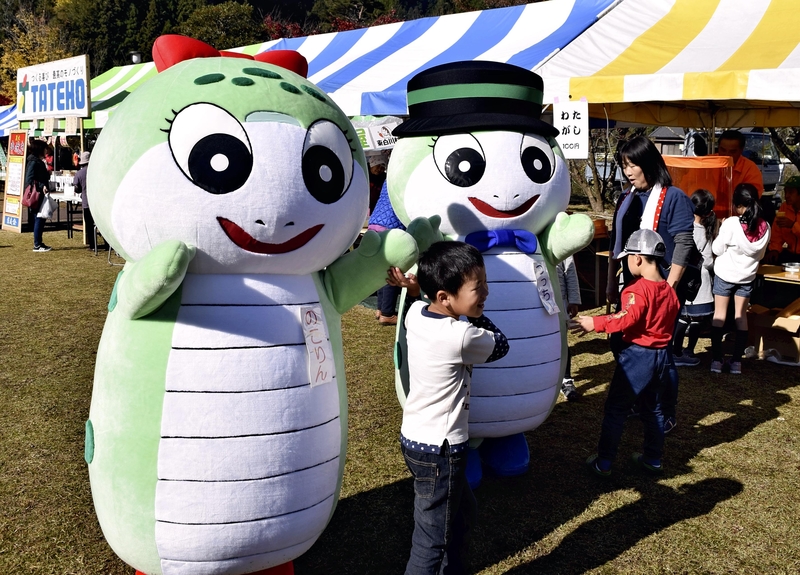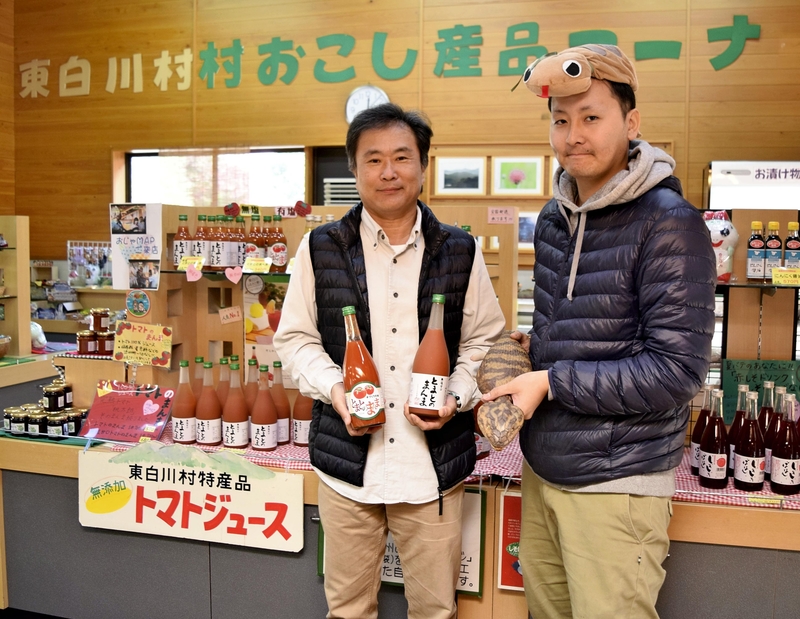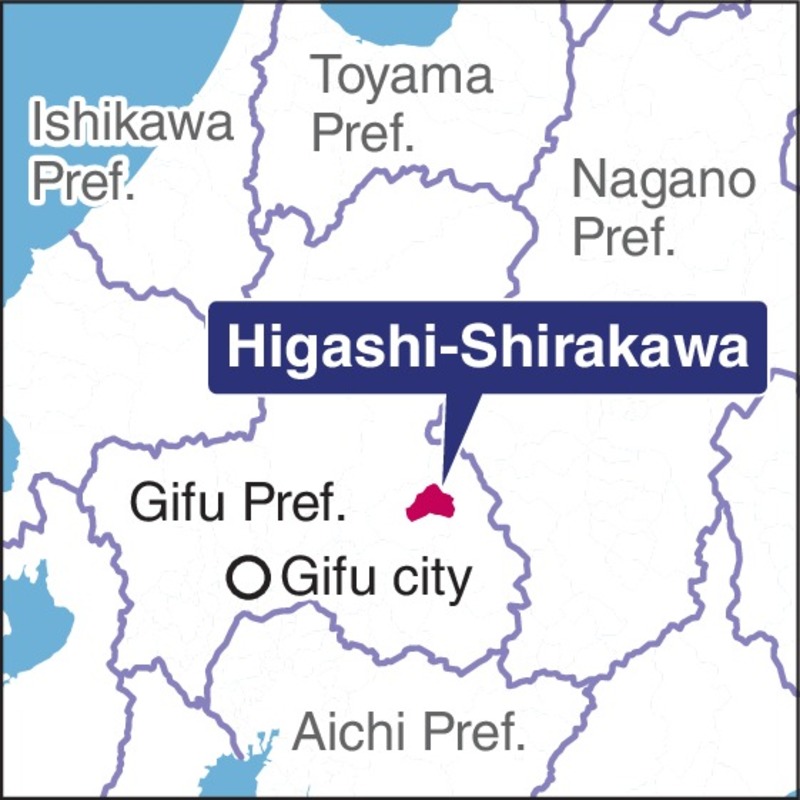
GIFU -- Higashi-Shirakawa, a village in Gifu Prefecture, has been attempting to vitalize itself by using "tsuchinoko," a kind of snake-like mythical creature.
The village government's website carries information of past tsuchinoko sightings in order to stimulate viewers' curiosity. One of the sighting reports around 1987 said, "It looked like a blackish beer bottle."
The village boasts of the largest number of tsuchinoko sighting reports in Japan. With the aim of vitalizing the local community, the village has spent the Heisei era (1989-2019) celebrating tsuchinoko.

On Nov. 11, 2018, the village held its autumn harvesting festival, including a competitive exhibition for local specialty agricultural products. Among the displayed products were goods named after tsuchinoko, such as "Tsuchinoko Cookie."
Mascot characters dressed as tsuchinoko, named "Tsutchi" and "Nokorin," appeared in the festival. The mascot characters spread good cheer and children smiled while being photographed with them.
Tsuchinoko began causing a sensation across the nation in the 1970s. In the 1980s, reports of sightings were made one after another.

In 1988 in Higashi-Shirakawa, local volunteers wrote reports in the village newsletter about sightings of a "phantom snake," with the aim of using the creature as a trigger for vitalizing the local community.
After that, a large number of sightings were reported, describing the image of tsuchinoko's appearance, "Its body is 30 to 80 centimeters long, and its head triangular."
The village began to bill itself as the place of the largest number of tsuchinoko sightings in Japan, promising a 1 million yen cash reward to anybody who could catch the creature alive.
That was the start of the village's efforts to vitalize the local communities, which it has since continued.
The following year, when the era name changed to Heisei, happened to be the Year of the Snake in the Chinese calendar. In April that year, a Shinto shrine named "Tsuchinoko Jinja" was built in the village.
The first big campaign to catch tsuchinoko was held the following month, with about 300 participants from all over the country.
Masato Katsuragawa, 89, then mayor of the village, said wryly, "If many were caught, I would finance the reward money from my own pocket."
In 1991, Furusato Kikaku, a company jointly capitalized by the public and private sectors, was established to vitalize the village. Shareholders of the company include village residents.
The company's office building was built with 100 million yen distributed to all municipalities by the Cabinet of then Prime Minister Noboru Takeshita.
Kazuhiro Murakumo, 56, the current Furusato Kikaku president and a native of Higashi-Shirakawa, came back from Nagoya and took a job with the company.
He recalled those years, saying, "I spent years together with tsuchinoko, and have made efforts to promote the attractiveness of this village."
Exclusive archives
In 1992, next to the Furusato Kikaku office, the village built Tsuchinoko-kan, which houses the Tsuchinoko Shiryokan archives, believed to be the only facility dedicated to tsuchinoko, and a section selling souvenirs related to the creature.
Battery-powered models of tsuchinoko are also displayed in the facility, which people from all over the nation still visit.
Murakumo said that he and his employees always devise ways to have visitors buy its local specialty products. The company developed "Tomato no Manma," a brand of tomato juice without additives, made from tomatoes produced in the village.
In 2018, the village for the first time organized a trail running event in which participants enjoy natural environments peculiar to the village's satoyama community forests and mountains while searching for tsuchinoko there. With such products and events, the village continues to create its new charms.
There is no train station in Higashi-Shirakawa. To reach the village, it takes about two hours by car from Gifu city, the prefecture's capital.
The village's birthrate has been on the decline and its population has been increasingly graying. It is predicted that the village's population will halve to about 1,100 by 2045.
Yuhei Taguchi, 28, works in charge of sales promotion at Furusato Kikaku. Taguchi was born the year the company was established. "I want to increase the village's attractions to make young people want to come here," he said emphatically.
The massive search for tsuchinoko is held on May 3 every year. The village's tourist association said the search was canceled in 2018 due to bad weather, but the 2017 search attracted about 2,900 participants -- a number larger than the village's population.
The amount of the cash reward, which started at 1 million yen, has been raised by 10,000 yen every year following the search's initial launch. The amount in 2019 is 1.3 million yen.
In the village, no major reports of any sightings have been made since 1990. But Katsuragawa said, "Tsuchinoko have become an 'intangible asset' of which this village is proud."
The village's history continues together with its glamorization of tsuchinoko.
Up to 100 million yen reward
There are other municipalities across the nation that aim to vitalize their local communities through the search for tsuchinoko.
Itoigawa, Niigata Prefecture, has organized an annual event called Tsuchinoko Tankentai. If a participant catches a tsuchinoko, the cash reward is as much as 100 million yen.
The city government also offers "Tsuchinoko Manju" sweets to people who provide reports of sightings of the creature, and cash rewards ranging from 100,000 yen to 1 million yen to people who provide photos of tsuchinoko.
In part of Akaiwa, formerly a town named Yoshii in eastern Okayama Prefecture, a resident found a body of a creature similar to tsuchinoko in 2000. An expert who examined it reported that it was different from ordinary snake species.
That year, the town government established an outline on the provision of a cash reward of 20 million yen for catching a tsuchinoko alive. Since then, the cash reward has been raised by 10,000 yen every year.
-- Higashi-Shirakawa, Gifu Pref.
The village is located in a mountainous area in the eastern part of the prefecture. This year marks the 130th anniversary of its foundation. Mountain forests account for about 90 percent of its total area.
Higashi-Shirakawa is known as a production area of Tono Hinoki, a cypress wood used as a luxury construction material. Other local specialty products include Shirakawa Cha, high-quality tea leaves grown on tea farms in mountainous areas, and sweet tomatoes harvested in summer and autumn.
It is also known as a village with no Buddhist temples, as the temples were all destroyed in the midst of Haibutsukishaku -- a movement in the wake of the 1868 Meiji Restoration under a government policy to make Shinto a national religion.
Its population peaked at 5,165 in 1947 and has since been continuously decreasing. It was 2,283 at the end of November 2018.
Read more from The Japan News at https://japannews.yomiuri.co.jp/







